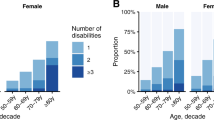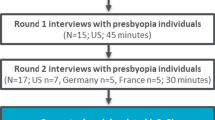Abstract
Background
The ability to perform many daily tasks relies on good visual acuity at various distances. A review of existing measures of visual function revealed gaps in task content, particularly tasks that rely on intermediate vision.
Purpose
This research sought to extend the content base and visual range coverage of tasks used to assess visual function.
Methods
Ophthalmology patients (n = 72) with myopia, hyperopia, presbyopia, astigmatism, cataracts, and/or glaucoma were involved in various qualitative sub-studies, including life event journaling, telephone interviews, and both on-line and face-to-face focus groups. The resulting journal entries and transcripts were thematically analyzed to identify visual tasks that rely on visual acuity in the near, intermediate, and distant visual ranges.
Results
A wide variety of distance-specific visual tasks were identified. Certain types of tasks relied on distance vision, such as; ambulation, driving, leisure and sports, and social functions. Other task groupings such as technology use and activities of daily living relied primarily on near and intermediate vision. Two new content areas were identified, technology use and safe task performance.
Conclusions
This thematic analysis provides a rich body of information about tasks that affect daily life and are made more difficult by poor visual acuity at various distance ranges.

Similar content being viewed by others
Notes
The search strings are available as an on-line supplement.
Information on measures associated with low vision or retinal problems such as age-related macular degeneration was not included in this table but is available on request.
This information was collected and summarized following the US FDA Guidance on PRO instrument design and validation [39]. The project protocol was approved by the Institutional Review Board under the University of California, San Diego, Human Research Protection Program (Study Series 1: 081637; Study Series 2: 090116).
References
Vitale, S., Ellwein, L., Cotch, M. F., Ferris, F. L., 3rd, & Sperduto, R. (2008). Prevalence of refractive error in the United States, 1999–2004. Archives of Ophthalmology, 126, 1111–1119.
Chalita, M. R., & Krueger, R. R. (2004). Correlation of aberrations with visual acuity and symptoms. Ophthalmology Clinics of North America 17, 135–142, v–vi.
Villa, C., Gutierrez, R., Jimenez, J. R., & Gonzalez-Meijome, J. M. (2007). Night vision disturbances after successful LASIK surgery. British Journal of Ophthalmology, 91, 1031–1037.
Long, G. M., & Garvey, P. M. (1988). The effects of target wavelength on dynamic visual acuity under photopic and scotopic viewing. Human Factors, 30, 3–13.
Rosenberg, E. A., & Sperazza, L. C. (2008). The visually impaired patient. American Family Physician, 77, 1431–1436.
Wong, T. Y., Foster, P. J., Johnson, G. J., & Seah, S. K. (2003). Refractive errors, axial ocular dimensions, and age-related cataracts: The Tanjong Pagar survey. Investigative Ophthalmology & Visual Science, 44, 1479–1485.
Lee, A. J., Saw, S. M., Gazzard, G., Cheng, A., & Tan, D. T. (2004). Intraocular pressure associations with refractive error and axial length in children. British Journal of Ophthalmology, 88, 5–7.
Pande, A., et al. (2001). Crystal cataracts: human genetic cataract caused by protein crystallization. Proceedings of the National Academy of Sciences of the USA, 98, 6116–6120.
Kupfer, C. (2000). The National Eye Institute’s low vision education program: Improving quality of life. Ophthalmology, 107, 229–230.
Frost, N. A., et al. (1998). Development of a questionnaire for measurement of vision-related quality of life. Ophthalmic Epidemiology, 5, 185–210.
Mangione, C. M., et al. (2001). Development of the 25-item National Eye Institute Visual Function Questionnaire. Archives of Ophthalmology, 119, 1050–1058.
Massof, R. W., & Rubin, G. S. (2001). Visual function assessment questionnaires. Survey of Ophthalmology, 45, 531–548.
Lamoureux, E. L., et al. (2008). An evaluation of the 10-item vision core measure 1 (VCM1) scale (the Core Module of the Vision-Related Quality of Life scale) using Rasch analysis. Ophthalmic Epidemiology, 15, 224–233.
Gupta, S. K., et al. (2005). The development of the Indian vision function questionnaire: Field testing and psychometric evaluation. British Journal of Ophthalmology, 89, 621–627.
Nelson, P., Aspinall, P., Papasouliotis, O., Worton, B., & O’Brien, C. (2003). Quality of life in glaucoma and its relationship with visual function. Journal of Glaucoma, 12, 139–150.
Mangione, C. M., et al. (1992). Development of the ‘Activities of Daily Vision Scale’. A measure of visual functional status. Medical Care, 30, 1111–1126.
Altangerel, U., Spaeth, G. L., & Steinmann, W. C. (2006). Assessment of Function Related to Vision (AFREV). Ophthalmic Epidemiology, 13, 67–80.
Hart, P. M., Stevenson, M. R., Montgomery, A. M., Muldrew, K. A., & Chakravarthy, U. (2005). Further validation of the Daily Living Tasks Dependent on Vision: Identification of domains. British Journal of Ophthalmology, 89, 1127–1130.
Bechetoille, A., et al. (2008). Measurement of health-related quality of life with glaucoma: Validation of the Glau-QoL 36-item questionnaire. Acta Ophthalmologica, 86, 71–80.
Terwee, C. B., Gerding, M. N., Dekker, F. W., Prummel, M. F., & Wiersinga, W. M. (1998). Development of a disease Specific Quality of Life Questionnaire for patients with Graves’ ophthalmopathy: The GO-QOL. British Journal of Ophthalmology, 82, 773–779.
Lee, B. L., et al. (1998). The Glaucoma Symptom Scale: A brief index of glaucoma-specific symptoms. Archives of Ophthalmology, 116, 861–866.
Burr, J. M., Kilonzo, M., Vale, L., & Ryan, M. (2007). Developing a preference-based Glaucoma Utility Index using a discrete choice experiment. Optometry and Vision Science, 84, 797–808.
Weih, L. M., Hassell, J. B., & Keeffe, J. (2002). Assessment of the impact of vision impairment. Investigative Ophthalmology & Visual Science, 43, 927–935.
Lamoureux, E. L., et al. (2007). The impact of vision impairment questionnaire: An assessment of its domain structure using confirmatory factor analysis and Rasch analysis. Investigative Ophthalmology & Visual Science, 48, 1001–1006.
Owsley, C., McGwin, G. J., Scilley, K., & Kallies, K. (2006). Development of a questionnaire to assess vision problems under low luminance in age-related maculopathy. Investigative Ophthalmology & Visual Science, 47, 528–535.
Hays, R. D., et al. (2003). Psychometric properties of the National Eye Institute-Refractive Error Quality of Life instrument. Ophthalmology, 110, 2292–2301.
Berry, S., Mangione, C. M., Lindblad, A. S., & McDonnell, P. J. (2003). Development of the National Eye Institute refractive error correction quality of life questionnaire: Focus groups. Ophthalmology, 110, 2285–2291.
Nichols, J. J., Mitchell, G. L., Saracino, M., & Zadnik, K. (2003). Reliability and validity of refractive error-specific quality-of-life instruments. Archives of Ophthalmology, 121, 1289–1296.
Dreer, L. E., et al. (2007). Development of a nursing home vision-targeted health-related quality of life questionnaire for older adults. Aging and Mental Health, 11, 722–733.
Schein, O. D. (2000). The measurement of patient-reported outcomes of refractive surgery: The refractive status and vision profile. Transactions of the American Ophthalmological Society, 98, 439–469.
Garamendi, E., Pesudovs, K., Stevens, M. J., & Elliott, D. B. (2006). The Refractive Status and Vision Profile: Evaluation of psychometric properties and comparison of Rasch and summated Likert-scaling. Vision Research, 46, 1375–1383.
Janz, N. K., et al. (2001). Quality of life in newly diagnosed glaucoma patients: The Collaborative Initial Glaucoma Treatment Study. Ophthalmology 108, 887–97. Discussion 898.
du Toit, R., Palagyi, A., Ramke, J., Brian, G., & Lamoureux, E. L. (2008). Development and validation of a vision-specific quality-of-life questionnaire for Timor-Leste. Investigative Ophthalmology and Visual Science, 49, 4284–4289.
Pesudovs, K., & Coster, D. J. (1998). An instrument for assessment of subjective visual disability in cataract patients. British Journal of Ophthalmology, 82, 617–624.
Uusitalo, R. J., Brans, T., Pessi, T., & Tarkkanen, A. (1999). Evaluating cataract surgery gains by assessing patients’ quality of life using the VF-7. Journal of Cataract and Refractive Surgery, 25, 989–994.
Javitt, J. C., Jacobson, G., & Schiffman, R. M. (2003). Validity and reliability of the Cataract TyPE Spec: An instrument for measuring outcomes of cataract extraction. American Journal of Ophthalmology, 136, 285–290.
Lawrence, D. J., Brogan, C., Benjamin, L., Pickard, D., & Stewart-Brown, S. (1999). Measuring the effectiveness of cataract surgery: The reliability and validity of a visual function outcomes instrument. British Journal of Ophthalmology, 83, 66–70.
Mangione, C. M., et al. (1998). Psychometric properties of the National Eye Institute Visual Function Questionnaire (NEI-VFQ). NEI-VFQ Field Test Investigators. Archives of Ophthalmology, 116, 1496–1504.
US Food and Drug Administration: Guidance for Industry. Patient-reported outcome measures: Use in medical product development to support labeling claims. http://www.fda.gov/downloads/Drugs/GuidanceComplianceRegulatoryInformation/Guidances/UCM193282.pdf.
Stone, A. A., Kessler, R. C., & Haythornthwaite, J. A. (1991). Measuring daily events and experiences: Decisions for the researcher. Journal of Personality, 59, 575–607.
National Eye Institute & Lions Clubs International Foundation. (2007). 2005 survey of public knowledge, attitudes, and practices related to eye health and disease. Bethesda, MD: National Eye Institute. Available at: http://www.nei.nih.gov/nehep/kap/.
Acknowledgments
We would like to thank Charmie E. Chirgwin, RN, PRO-Spectus, Inc., San Diego, CA, for her supportive role with study management and patient recruitment. Funding for this research was provided by Alcon Research, Ltd.
Author information
Authors and Affiliations
Corresponding author
Electronic supplementary material
Below is the link to the electronic supplementary material.
Rights and permissions
About this article
Cite this article
Atkinson, M.J., Tally, S., Heichel, C.W. et al. A qualitative investigation of visual tasks with which to assess distance-specific visual function. Qual Life Res 22, 437–453 (2013). https://doi.org/10.1007/s11136-012-0154-2
Accepted:
Published:
Issue Date:
DOI: https://doi.org/10.1007/s11136-012-0154-2




